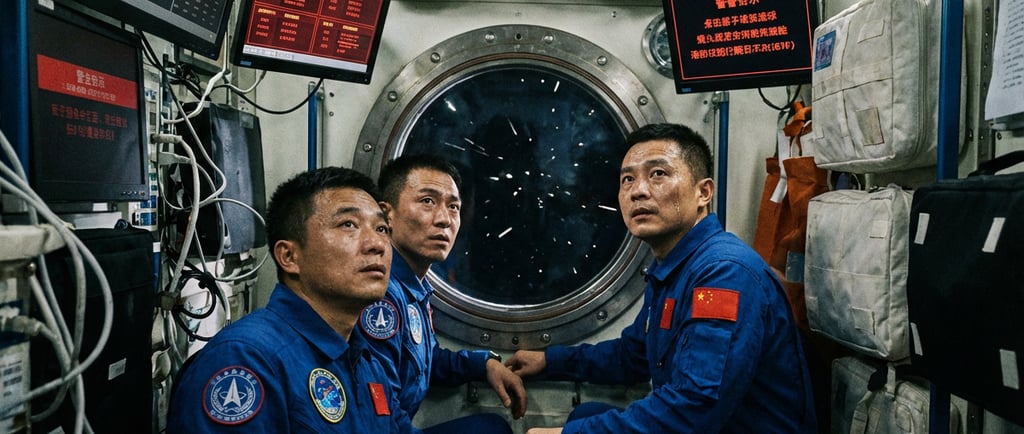Orbit Lockdown: Three Taikonauts Trapped on Tiangong Station by Space Debris Field
The return journey of the Shenzhou crew has been indefinitely postponed. A dense cloud of high-velocity space junk has surrounded the Tiangong station, turning a routine homecoming into a high-stakes survival scenario.
CHINACULTURESPACE


Red Alert in Orbit: Taikonauts Trapped on Tiangong by Debris Cloud
November 20, 2025 – The routine undocking procedure for the latest Shenzhou mission has turned into a tense standoff in Low Earth Orbit (LEO). The China Manned Space Agency (CNSA) has confirmed that three taikonauts currently aboard the Tiangong space station are effectively "stuck" in space, unable to initiate their return journey due to a hazardous field of space debris encompassing their orbital trajectory.
This developing situation highlights the growing and terrifying reality of the "Kessler Syndrome"—a scenario where the density of objects in LEO becomes so high that collisions between objects cause a cascade, rendering space travel perilous.
The Invisible Wall: What Happened?
Early this morning, ground control in Beijing detected a fragmentation event—likely the breakup of a defunct satellite or an upper-stage rocket body from a previous international launch. This event generated thousands of pieces of trackable debris and millions of untrackable flecks of paint and metal, all traveling at speeds exceeding 17,500 miles per hour (28,000 km/h).
While the Tiangong station itself is equipped with shielding and thrusters to perform evasion maneuvers, the current density of the debris field makes the undocking and re-entry phase of the Shenzhou spacecraft statistically suicidal.
"The risk isn't just hitting the station," explains orbital dynamics analyst Dr. Sarah Jenkins. "The risk is the return capsule. If the Shenzhou spacecraft undocks and attempts to lower its orbit through this 'shrapnel cloud,' a single impact from an object the size of a screw could catastrophically breach the heat shield."
Life Under Lockdown
For the three taikonauts, the mission has shifted from scientific research to survival management. They have been ordered to retreat to the Tianhe core module, the most heavily shielded section of the station.
According to CNSA reports, the crew is currently:
Conserving Resources: Oxygen and water recycling systems are running at peak efficiency, but consumables intended for the return trip are being rationed.
Sealing Hatches: All internal hatches between modules (Wentian and Mengtian) have been sealed to prevent total depressurization in the event of a hull breach in a laboratory module.
Wearing Pressure Suits: The crew is spending designated periods in their intra-vehicular activity (IVA) suits as a precaution against sudden decompression.
The Challenge of a Rescue Window
The primary issue facing mission control is not how to get them down, but when. Space debris does not stay in a static cloud; it disperses over time, creating "lanes" of safety. However, predicting these lanes requires immense computational power and precise radar tracking.
The CNSA is currently collaborating with international tracking networks to map the debris field. They are waiting for a "safe corridor"—a temporal window where the probability of impact drops below the acceptable safety threshold (usually 1 in 10,000). Until that window opens, the Shenzhou spacecraft remains docked, serving as a lifeboat that cannot yet launch.
The Broader Threat: A Crowded Sky
This incident serves as a grim wake-up call for the global space industry. As of late 2025, the number of satellite constellations has exploded, drastically increasing orbital congestion.
Experts warn that this "lockdown" might not be an isolated incident. If debris generation continues at this rate, access to space could become seasonal or sporadic, dictated by the movement of junk clouds rather than mission schedules. For now, the world watches and waits, hoping for the sky to clear for the three stranded explorers.
Sources
China Manned Space Agency (CNSA) Official Press Releases
European Space Agency (ESA) Space Debris Office: "Annual Space Environment Report"
NASA Orbital Debris Program Office: "Hypervelocity Impact Guidelines"
Secure World Foundation: "Global Counterspace Capabilities"


